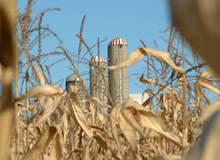
Starting any project or business from scratch during the financial crisis is tough. It is testament to the concept and technology that Peter van der Gaag and his team at Bio-Ethanol Rotterdam (BER), even during these hostile market conditions, plan to build an innovative biofuels plant endure.
Along with the market fundamentals, a number of factors are making biofuels an interesting sector to be involved in during 2009. As President Barack Obama gave his somewhat cautious backing to the industry in the US, European fuel quality directives, country-specific excise duties and the need to amplify efficiency each began presenting challenges and opportunities of their own. All these topics and the latest BER developments will be discussed when industry leaders meet at the ViB Biofuels Supply Chain Summit 2009 in Belgium between 15-17 September.
Evolving concept
The concept for the project started in 2004 when a group of technical specialists, including van der Gaag, wanted to make the most sustainable biofuels project possible at a site near to the Port of Rotterdam that could leverage off existing infrastructure. “We wanted to clean the air in Rotterdam, using very good logistics but no fossil fuels, emissions or waste,” van der Gaag says.
The first step is to use conventional fermentation to make 125,000 litres of bioethanol and food-grade carbon dioxide, aqueous ammonia, digestate and green electricity. Here, wheat is used as feedstock in a state-of-the-art complex that recycles the vast majority of any waste. To avoid any opposition from environmental organisations, oil or food companies the concept evolved to also incorporate the production of liquid biomethane, or bio-Liquefied Natural Gas (LNG).
The bio-LNG concept involves putting inexpensive agricultural and food waste through a production process of anaerobic digestion that only needs a maximum temperature of 55°C. From this, biogas can be produced. As this contains a compound mixture of 35% carbon dioxide (CO2) and 65% methane, the CO2 is then extracted to create biomethane. The process to liquefy it is then relatively simple and bio-LNG is made.

US Tariffs are shifting - will you react or anticipate?
Don’t let policy changes catch you off guard. Stay proactive with real-time data and expert analysis.
By GlobalDataWith the backing of nine shareholders and feedstock that consists of vegetable waste and sewage sludge the project is both realistic financially and has silenced the critics of other sectors of the ethanol industry in the ongoing food versus fuel debate. And, as bio-LNG can be used in at least a fifth of the fossil fuels that power the EU transportation sector, the concept also has a tangible use.
“Some car companies already have experience with LNG, they have seen it is superior to other fuels and are therefore very interested in bio-LNG,” says van der Gaag. The shipping industry is also increasingly interested and as feedstock is so widely and cheaply available, any port is a potential for similar projects.
However, van der Gaag says that EU governments are not doing enough to encourage investment into this sector despite the possibilities.
“The governments are not aware of the enormous possibilities of bio-LNG and there are lobbies of oil companies and the present [ethanol] industry. However, the breakthrough will come quickly.”
The BER project has been granted permits and the BER team is working with the Port of Rotterdam to develop processes of how ‘surplus’ heat originating from the processing of waste from the site’s neighbours can be used in the plants production processes. In addition, the port has storage capacity and pipeline infrastructure. Now van der Gaag is working on getting financial closure and alongside the Rotterdam project is looking at another site in the north of The Netherlands to construct a plant to solely focus on anaerobic digestion.
Public perceptions
Having once been hailed as a saviour resource for the fossil-fuel dominated power industry, the production of ethanol soon fell from grace with the eruption of the food versus fuel debate and government subsidy policies, which often favoured one purpose of wheat production over another.
In addition, analysis from life cycle studies argued that the use of fossil fuels in ethanol’s production, the use of fertiliser in the growing of wheat and the fuel used in the transportation of the product all made this eco-friendly material less green than it first seemed.
But van der Gaag is working hard to make sure that none of these criticisms can be cast towards his Rotterdam project. As far as possible it will use wheat that is not suitable for human consumption and BER is looking for African growing sites where farmers won’t suffer the same import duties that are inflicted on food produce. As already mentioned, the power will be sought from excess steam of nearby industries and the plant will be carbon neutral.
Even the greenest of projects is still impacted by the market fundamentals, however. “With the financial crisis it is not easy to get projects off the ground and many biofuel firms have gone bankrupt,” van der Gaag says. “European producers of biodiesel are not making a profit at the moment with such a low oil price in Europe and bioethanol is the same.”
But van der Gaag is confident in its long-term potential and as bio-LNG is the cleanest and cheapest biofuel, which can even be produced from fish waste, he is betting wisely. The latest developments will be shared at the ViB Biofuels Supply Chain Summit 2009 where other exciting projects will also be showcased.



